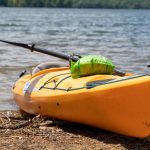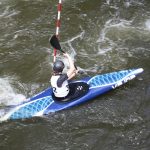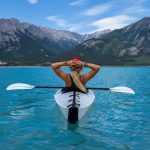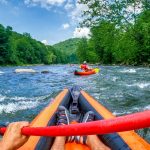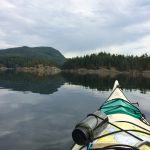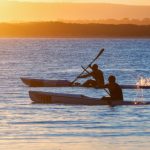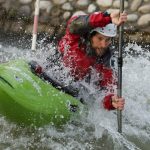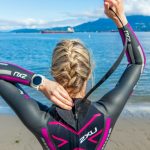A dry bag will keep your items safe against rain, dust, dirt and submersion. In this post, we take a look at the best kayaking dry bags currently available.
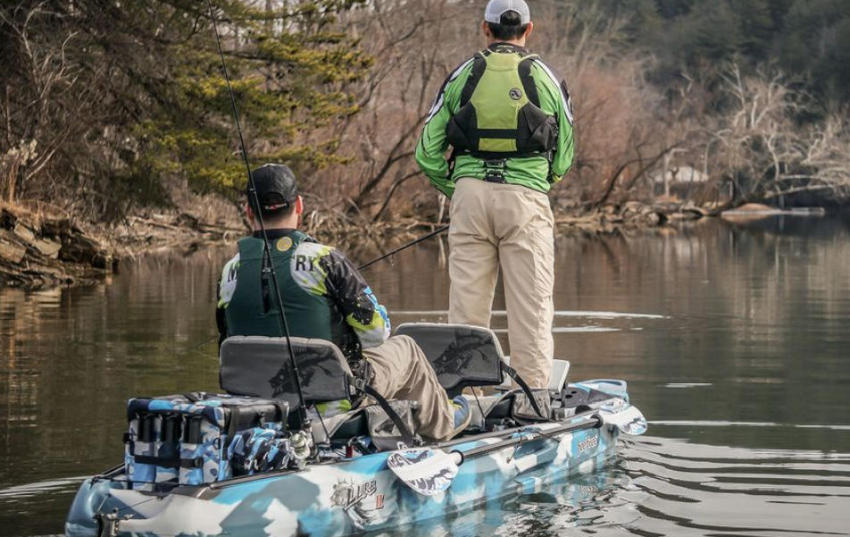
Summer kayaking is always an absolute delight. There’s nothing but you, the bright sun, and the warm water, and it’s lovely to wear a pair of swim shorts so you can dive into the water to cool off after a long paddle.
But spring, winter, or autumn kayaking, that’s a different story altogether.
You’re going to have to wear a lot more than just shorts and a T-shirt if you want to avoid getting cold. During these months, you’ve got to adhere to the simple rule of kayak clothing:
Dress for the water temperature, not the weather.
For the cool, cold, or downright frigid days, that means a thick jacket, kayaking gloves, and, most important of all, a good pair of pants to protect your legs.
Below, we’ve collected a list of all the best kayaking pants on the market. These bad boys combine quality synthetic fabrics with a comfortable design—and waterproofing, in some cases. They’ll provide you with lower body protection from the cold, water, and solar radiation.
Check out our list, and make sure to read through the buying guide and FAQs sections to learn everything you need to know about choosing the best kayaking pants for your paddling trips.
As an affiliate of Amazon and other retailers, we may earn a small commission when you buy via our links, at no additional cost to you. Thank you!
Quick Answer: The Best Kayaking Pants for You
Don’t have time to read the whole article? No worries! Check out our condensed list to find the best kayaking pants:
- Columbia Men’s Silver Ridge Convertible Pants
- Columbia Men’s Blood and Guts Pant
- Under Armour Men’s Fish Hunter Cargo Pants
- Marmot PreCip Full Zip Pants
- NRS HydroSkin Pants (lined with soft material so more comfortable to wear than bare neoprene)
- NRS Endurance Pants
- Kokatat Men’s Hydrus Stance Paddling Pants
- Kokatat Session Semi-Dry Pants (neoprene ankle gaskets will keep you dry when your kayak starts to collect water of when you wade to shore)
- Kokatat Hydrus Tempest Dry Pants (to pair with a dry top for cold weather kayaking. But really, we would recommend investing in a dry suit for those conditions)
Top-Rated Kayaking Pants
Columbia Men’s Silver Ridge Convertible Pants
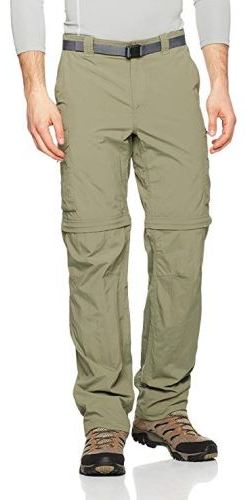
Material: Ripstop nylon
UPF Protection: UPF 50
Waterproof: No
Columbia is a brand best-known for its sport-friendly clothing, the perfect blend between durability, comfort, and versatility. These pants are exactly what you need for a day of paddling, hiking, and camping.
They’re designed to be converted to shorts, with a removable pant leg that comes off easily with just a zipper. Whether in pants or shorts form, however, they’re incredibly tough—made from Columbia’s signature ripstop nylon—and offer good protection from the sun (UPF50).
The pants aren’t 100% waterproof, but they will keep you dry from splashes or rainfall. Pair them with a good pair of waterproof shoes or boots and a waterproof rain jacket, and you’ll stay dry all day long. Plus, they’re also lined with a moisture-wicking fabric that keeps you cool even when the weather gets hot.
Pros:
- Supremely comfortable
- Hard-wearing, durable, and guaranteed to last for years of regular use
- Excellent functionality and versatility
- Great for hot and cool weather
- Lightweight, good freedom of movement
Cons:
- Not fully waterproof, only water-resistant
- Fit is very slim, not suited for thicker, heavier men
Columbia Men’s Blood and Guts Pant
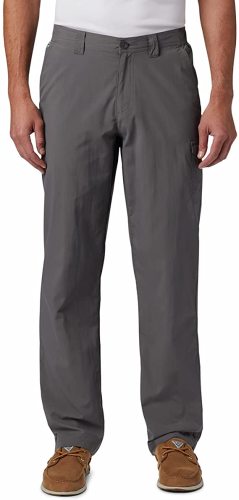
Material: Ripstop nylon
UPF Protection: UPF 30
Waterproof: No
If you’re a fisherman who does all their angling from a kayak, these pants are your best pick. They’re not 100% waterproof, merely water-resistant, but what makes them truly amazing is that they’re coated with a stain-resistant Omni-Shield treatment that will repel mud, dirt, and fish guts. They can be easily rinsed off with a bit of water to keep them clean and looking good.
They do feature UPF30 protection from UV radiation, and the classic fit makes them comfortable for all-day wear. They hold up very well to impacts, rips, and damage thanks to the 100% ripstop nylon that makes Columbia pants so tough. And, in addition to the two side and back pockets, you also get a side pocket sized to hold a knife for easy access.
Fair warning: your phone may not fit in the Velcro-closed pockets, so you’ll have to find another way to transport it. And users weren’t thrilled by the high price tag—about 20-50% higher than some of the more affordable options on our list.
Pros:
- Durable and beautifully comfortable
- Water-resistant and stain-repellent
- Lightweight, great for hiking, fishing, and kayaking
- Quick-drying and moisture-wicking
Cons:
- On the pricier side
- Secure pocket too small to hold smartphone
Under Armour Men’s Fish Hunter Cargo Pants
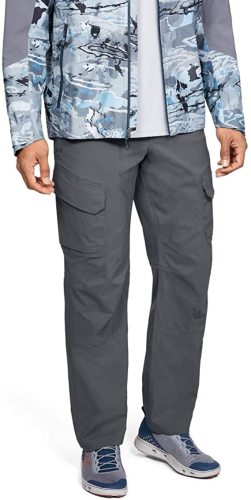
Material: Stretch-woven nylon
UPF Protection: UPF 30+
Waterproof: No
UnderArmour is a brand we’re all familiar with, thanks to their athletics-forward, supremely comfortable clothing. These pants may be exactly what you need if you plan on fishing from a kayak or canoe—anywhere you risk getting wet.
They’re not fully waterproof, merely water-resistant, but they also feature a stain-repellent coating that will stay clean even through gutting and cleaning your fish or portaging your kayak through muddy terrain. The pants are both salt- and chlorine-resistant, perfect for use on the ocean and in freshwater lakes and rivers. Thanks to the articulated knees and comfortable tapered leg fit, you have plenty of freedom to move around while still staying warm in cool weather.
Customers were less-than-thrilled by the overly small front pockets and cargo pocket, which don’t offer enough space for large-sized smartphones or a full-sized knife. Some also complained that the sizes tended to run small and the fit was a bit tight.
Pros:
- Wonderful for walking, hiking, fishing, camping, and paddling
- Keep you warm, dry, and clean all day long
- Synthetic stretch fabric and articulated knees make for comfortable movement
- Comfortable, no added interior lining to make them overly hot in summer
Cons:
- Pockets are too darned small
- Sizes run small, may be a tight fit
Marmot PreCip Full Zip Pants
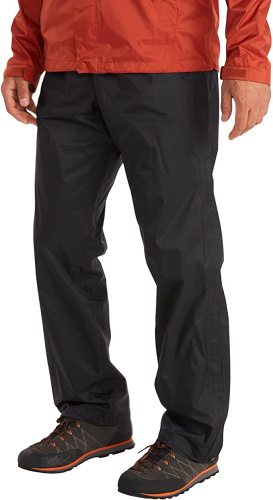
Material: Nylon
UPF Protection: Not specified
Waterproof: Yes
Looking for a good pair of fully waterproof pants that will get you through those cold, rainy days out on the lake or river? Give these bad boys a try!
Made using tough-and-rugged 100% PFC-free NanoPro recycled nylon, these pants are finished with a waterproof coating that will keep out all water even in the heaviest downpour or splashing around on the shore. Pair them with a good pair of rain boots, and your lower body will stay dry all day long. But don’t worry that they’ll be too hot—thanks to the advanced microporous coating, they’ll still be fully breathable and keep you from overheating.
The elastic waist will keep you moving comfortably but still offer good protection against water seeping down your pants, and you’ll find the fully taped seams and bonded storm flaps over the zippers maximize waterproofing. Best of all, the pants are covered by a lifetime warranty.
Users weren’t too pleased with the less-than-effect Velcro waist-closure system, and the too-short zippers were a point of contention. However, these have earned their place on this list by being tough and ultra reliable!
Pros:
- Comfortable and warm even in wet and rainy conditions
- Fully waterproof
- Great to fit over base layers in cold-weather kayaking trips
- Lightweight and sturdy
Cons:
- Velcro waist-closure system ineffective, and there are no belt loops
- Zippers may be too short
NRS HydroSkin Pants
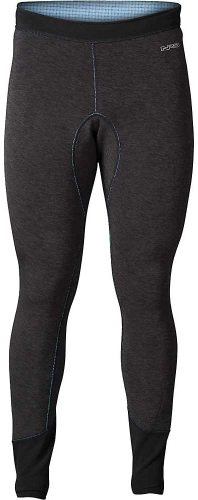
Material: Terraprene neoprene
UPF Protection: Not specified
Waterproof: Yes
Wear these bad boys under a wetsuit, rain pants, or fishing pants, and you’ll stay dry and comfortable all day long. They’re made using 1.5mm neoprene, which is fully waterproof and will keep the water away from your skin. They also feature a VaporLoft fleece inner lining that is both amazingly soft and adds impressive insulation.
The waistband features a zippered stash pocket for any small items you want to keep dry and on your person at all times. The waist drawcord will increase waterproofing capabilities and make sure the pants hug your hips nice and tight. The neoprene rubber is fully waterproof—with a special exterior coating for maximum efficiency—and will trap body heat close to your skin to keep you warm even in freezing conditions.
Pros:
- Perfect for paddleboarding or kayaking in cold weather
- True-to-size fit
- Very comfortable and versatile
- Good flexibility and mobility
Cons:
- Neoprene may be easily damaged, ripped, or punctured
NRS Endurance Pants
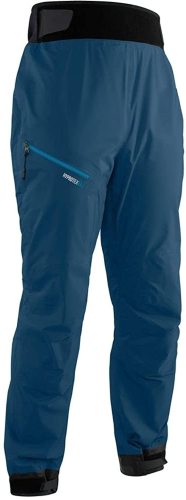
Material: HyproTex synthetic fabric
UPF Protection: Not specified
Waterproof: Yes
These paddling pants are designed specifically for kayakers, with an extra-secure hook-and-loop waistband that features a layer of neoprene that will keep water from seeping in even when the rain is pouring and choppy waters splash over the sides of your kayak. The HyproTex synthetic fabric (similar to Gore-Tex) is fully waterproof, too, but offers enough breathability that you won’t have to worry about overheating.
They’re great pants for cool-weather use, though they may be a bit too hot in the middle of summer. Both the seat and knees are reinforced with dual layers of fabric, preventing damage on the parts most likely to be worn down through repeated use. They’re definitely not the most affordable option on our list—far from it, in fact—and they won’t keep you fully dry if you capsize or end up swimming. However, for a good pair of waterproof paddling pants, they’re an awesome choice.
Pros:
- Fully waterproof, designed with elastic cuffs and waistband to keep out water
- Durable and comfortable
- Flexible, moves well with your paddling form
- Reinforced at the seat and knees
Cons:
- Pricey
- Sizing may run small/tight
Kokatat Men’s Hydrus Stance Paddling Pants
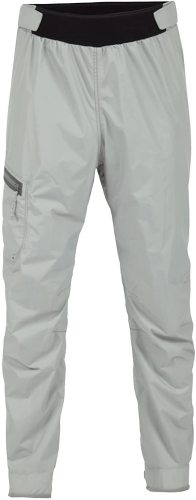
Material: Hydrus 2.5 synthetic fabriс
UPF Protection: Not specified
Waterproof: Yes
Made with Kokatat’s Hydrus membrane (a material similar to GoreTex), these are a fully waterproof pair of paddling pants designed specifically for kayakers. They’re lightweight and roomy enough that you can wear them over a base layer, but offer enough insulation that they’ll suffice to keep you warm in all but the coldest weather.
The adjustable hook-and-loop closure at the cuffs and adjustable neoprene waistbands (yes, TWO of them!) will ensure your lower body stays dry in a downpour or even when wading into the water to launch your kayak.
Sadly, the pants are so popular they often sell out and are unavailable (for weeks at a time).
Pros:
- 100% waterproof, even at the waist and ankles
- Comfortable and lightweight
- Can keep you dry even when standing in the water (for a few minutes at a time)
Cons:
- Often sold out/unavailable
Kokatat Session Semi-Dry Pants
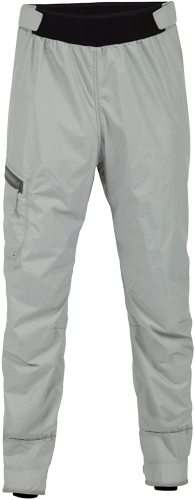
Material: Hydrus 2.5 synthetic fabric
UPF Protection: Not specified
Waterproof: No
These are called “semi-dry pants” because they’re merely water-repellent rather than fully waterproof. The Hydrus fabric is excellent at keeping out water, but the waist and cuffs feature only neoprene gaskets and hook-and-loop closures that are only 95% waterproof. They’re ideal for wading to shore or using when your kayak starts filling with water, but don’t expect to stay dry if you capsize or have to swim.
The pants are lightweight, comfortable, and breathable, with good ventilation that will keep you from feeling too hot or constricted all day long. They’re on the pricier side, though.
Pros:
- Neoprene ankle gaskets pull tight to keep water from leaking up your ankles
- Sturdy, waterproof fabric
- Semi-dry design, good for all but the wettest conditions
- Ideal for late fall and early spring paddling
Cons:
- Expensive
- Water will leak in if you swim or spend too much time in the water
Kokatat Hydrus Tempest Dry Pants
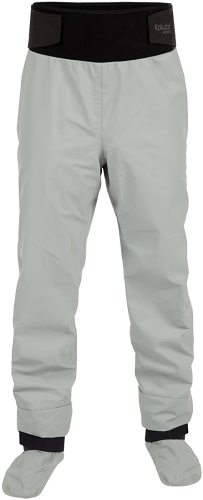
Material: Hydrus 3.0 synthetic fabric
UPF Protection: Not specified
Waterproof: Yes
If you want to stay ABSOLUTELY BONE DRY through even the wettest and coldest paddling trips, these dry pants are just what you need. Made with extra thick Hydrus synthetic fabric, they feature a hook-and-loop waistband with a layer of neoprene to keep even a single drop of water from sliding down your pants. And rather than stop at watertight ankle cuffs, these pants actually feature full foot coverage integrated into the pants. These pants will help you stay 100% dry no matter how much time you spend in the water.
They’re also roomy enough to accommodate a base layer (or two), making them perfect for cold-weather kayaking when you need to stay ultra-warm. Pair them with a dry top, and you’ll always be cozy and toasty no matter how frigid the water temperature gets.
Pros:
- 100% dry even when wading or swimming
- Suitable for winter/cold-weather kayaking
- Durable fabric
- Fully waterproof pants and waistband
Cons:
- Expensive
- Must be paired with a dry top (Note: You might want to consider investing in a full dry suit rather than buying pants and tops separately.)
Complete Buyer’s Guide: What to Consider When Choosing Kayaking Pants
Types
For the sake of thoroughness, we can’t talk about kayaking pants without also talking about kayak shorts.
Kayak shorts come in a few different styles:
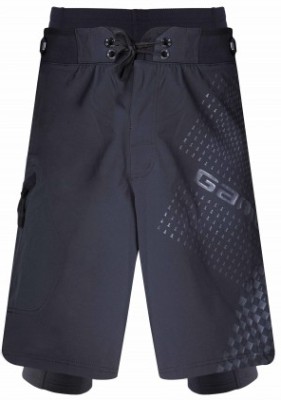
Paddling Shorts – These are typically shorter in length (mid-thigh to above the knee) and tend to be a bit more flexible, very similar in design to running shorts. Their shorter length gives them full versatility and makes it easy to move your legs when powering through a fast paddling stroke.
Board Shorts – Board shorts are the classic surfing wear that pretty much everyone uses because they’re designed to be loose, flexible, and both moisture-wicking and quick-drying. They’re a bit longer—typically around or below knee length—but beautifully lightweight and versatile for every watersport.
Neoprene Shorts – These are basically “wetsuit shorts”, worn to protect against rashes caused by friction, as well as offering some insulation in cold water. They’re not as effective at keeping you warm as full-length wetsuit pants, but they’ll be warmer than your basic paddling or board shorts.
Fleece- or Neoprene-Lined Shorts – These shorts are slightly thicker than your average board shorts, made using nylon (or some other waterproof fabric) on the outside and an inner lining of neoprene or fleece to keep you warm. The fleece/neoprene will trap air inside to insulate your upper legs. However, they’ll get soggy when wet, so they’re better off for dry paddling conditions.
With shorts out of the way, it’s time to talk about the real reason you’re here: kayaking pants.
Kayaking pants come in a few different styles:
Leggings – Leggings are the lightest-weight option, great for those warm and slightly cool days on the water. They offer just enough coverage that your legs won’t feel the chill, and are typically made from moisture-wicking and quick-drying synthetic fabrics that won’t suffer from getting damp/wet.
Splash Pants – Splash pants are basically the lower body equivalent of a windbreaker or raincoat. They’re designed to be pulled on over your board shorts, boxers, leggings, or thin pants, and they serve as an outer waterproof layer to protect against splashes. They’re not very warm, which is why they’re best-suited to be worn as a top layer.
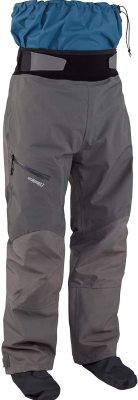
Fishing Pants – Fishing pants are designed for anglers who are standing on the shore/pier/dock, intended to protect them from splashing water. They’re typically made from a waterproof or water-resistant fabric, and some include an inner lining of fleece to maximize insulation in cold weather. They’ll also include a lot of pockets and special clip-on points for fishing gear.
Rain Pants – Rain pants are designed to be worn specifically in the rain, which means they include waterproofing at the waist and ankles that will shield your underclothing from getting wet. They may include additional interior insulation and though lightweight, will be highly durable and made for cold and wet conditions.
Wetsuit Pants – Wetsuit pants are made using neoprene, a fully waterproof material that keeps water out and traps it in. They’re actually designed to fill up with water, which is then heated by your body heat and acts as a layer of insulation to shield you from cold water or ambient temperatures. They’re a good choice if there’s a chance you’ll get wet—such as out on the open ocean, whitewater kayaking, or kayaking in the rain or heavy winds.
Dry Pants – Dry pants are the next step up from splash pants. They’re designed to be fully waterproof, keep out all water from getting into your clothing. Typically, they’re made using nylon or some other sturdy, waterproof material, but are too thin to provide any real insulation. You’ll likely wear them over another pair of warm pants or leggings.
Waders – Waders can be an angler’s best friend (especially for fly fishing), and they can come in handy when kayaking in wet, rainy, or cold conditions. They can be worn over your clothing and eliminate the need for footwear. Plus, they’re usually insulated (at least a little) so they can keep you warm in cold weather.
Length
For swimming or lounging on the beach in warm weather, shorts are definitely the go-to for most people.
However, if you plan on doing some fishing or hunting (which may involve getting out of the kayak and onto the shore.), you may want to opt for longer pants. Not only will they protect your legs (from thick grasses, reeds, etc.), but they will include ample pockets for all of your gear.
For cold-weather paddling, you’ll definitely need pants to protect your lower legs from getting cold. Your circulation is already going to be reduced because you’re sitting down with your legs extended out in front of you, so the risk of losing sensation and getting a chill is much higher. Warm pants with extra layers of insulation or leggings worn beneath rain pants/splash pants will protect you from the cold.
And, remember: if there’s any chance you’ll end up in the water, you should be prepared for the chill. That means it may be a good idea to wear wetsuit pants or dry pants that can keep you warm even when wet.
Fabric
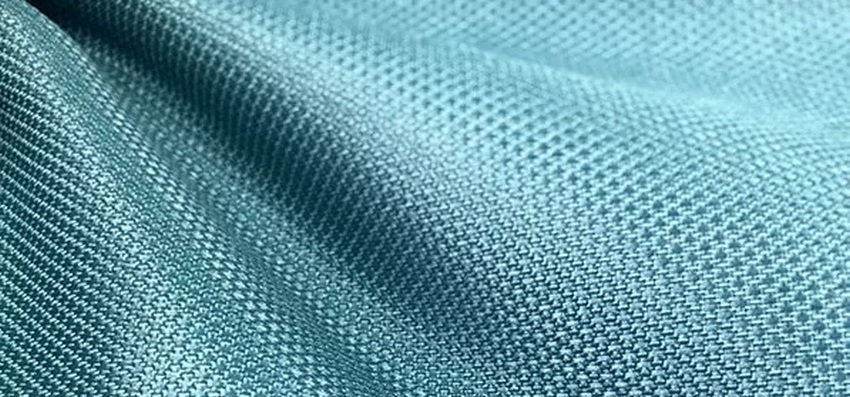
Kayaking clothes are usually made from one of a few different synthetic fabrics:
Spandex, Polyester, and Lycra – These are lightweight synthetic fabrics designed to flex and move with you as you paddle, and usually feature both moisture-wicking and quick-drying properties. They’re highly effective at keeping you dry and cool even in wet conditions, which is why they’re commonly used for athletic clothing, board shorts, and kayaking gear.
Nylon, PUL, TPU, PVC-Coated Fabrics – These are synthetic fabrics designed with special waterproofing. PUL, or polyurethane laminate, is polyester with a thin waterproof plastic coating on it. TPU, or thermoplastic polyurethane, is tougher, softer, and more flexible than PUL. Some synthetic fabrics are coated using PVC, or poly-vinyl chloride, to make them fully waterproof.
Fleece – Polyester fleece is a synthetic material with insulation properties on par with natural wool. It’s typically used as an inner lining beneath a waterproof layer, as, like wool, it tends to get waterlogged and heavy when wet.
Neoprene – Neoprene is a synthetic form of rubber, fully waterproof and sturdier than other synthetic fabrics. It’s usually used in wetsuits, though you can find some paddling shorts or pants that use a neoprene inner lining to add insulation.
RELATED: Best Kayaking Wetsuits for 2023
Waterproofing
Not all paddling pants are designed to keep out water. Some—such as leggings or athletic pants—will dry quickly and pull moisture away from your body, and they’re usually used for warm-weather paddling.
If you want to keep out the water, however, you can opt for waterproof pants (such as fishing pants or paddling pants) with their own insulation, or dry suit or rain pants worn over a warm base layer.
On the other hand, if you expect to be in cold water, wetsuit pants will actually use the water as an excellent form of insulation to protect you from the chill.
Durability
Durability is always a factor to consider when shopping for outdoor clothing.
Ripstop nylon is an excellent fabric for thicker pants—fishing pants, hiking pants, rain pants, and paddling pants. It’s designed to be resistant to rips and tears, and is sturdy enough to be used for multiple sports/recreational activities.
Polyester, Lycra, and Spandex will typically be less sturdy than nylon, but are lightweight and flexible, mostly used for athletic wear.
And, of course, neoprene is as tough as rubber, resistant to rips, tears, and even direct damage.
Insulation
When the weather turns icy, you need to keep your lower body warm!
For cold-weather kayaking, you’ll want to find a pair of kayaking pants that include some form of insulation—polyester fleece, neoprene, or even synthetic down fill.
Or, you can double up on layers and wear a pair of warm leggings beneath rain pants or drysuit pants.
Wetsuit pants are also highly effective at insulating your lower body when they’re filled with water, though even in dry conditions, the thick neoprene offers decent protection against the cold.
Breathability
You’d be surprised by how quickly you can heat up even in cold water. Synthetic, highly insulated fabrics will trap body heat close to your skin, which can feel quite stifling after a few hours of intense paddling and heavy sweating.
The polyester fleece used to line paddling pants and fishing pants offers poor breathability, which is why many kayaking pants will feature some sort of mesh interior or zipper aperture that you can open to allow air to escape.
Comfort
Comfort is an absolute must when planning an all-day or multi-day paddling trip! You need a pair of pants that can move with you as you drive your legs against the foot pedals, allows for good freedom of movement, and can keep up with all your other activities around kayaking (portaging your kayak, hiking to/from the campsite, making landfall, etc.).
Kayaking pants should be tight enough that they hug your legs and keep the body heat close to your skin in cold weather, but not so tight that they cut off circulation or prevent you from lounging in comfort when not paddling.
Compression

Compression can actually be a good thing for paddlers!
Compression increases blood flow to your legs, helping to maintain circulation. They also increase oxygenation of your muscles, which reduces cramps and keeps your legs working at optimum efficiency.
Compression leggings also make a great base layer beneath rain pants, dry pants, or even your standard fishing pants. In warm weather, you can wear them on their own, and their synthetic fabric will help them dry off quickly if they get wet.
Pockets
Talk to any angler or hunter, and they’ll tell you that pockets are an absolute MUST.
Think about it: you’ve got to carry a lot of gear—knives, hooks, line, lures, a flashlight, and so much more. Having enough pockets for it all will save you from having to pull out your tacklebox every few minutes to grab that one thing you forgot.
The good news is that most rain pants, fishing pants, and paddling pants will have a number of handy pockets, including a few zip-up pockets, cargo pockets, as well as front and back pockets.
The more pockets on your paddling pants, the better!
UV Protection
If you’re going to spend all day beneath the hot sun—either in summer or winter—you need protection against solar radiation.
Regularly getting sunburned or spending the hottest hours of the day (between 11 AM and 3 PM) in the sun can increase your risk of melanoma (skin cancer) and damage your skin.
Dark fabrics will protect against the sunlight, but ideally, you’ll want to look for kayaking pants that also feature some sort of UPF/SPF protection woven into the synthetic fabrics. Anything above UPF/SPF 30 will be enough.
Hardware
Last but not least, consider the hardware included on your pants. The closures should be Velcro or some variation of plastic, as neither of these materials will rust. If there are zippers, buckles, or belts, make sure they’re made from some rust-proof material—or, if metal, that they’re finished with a rust-proof coating.
Remember: any metal that is regularly exposed to water will rust over time, even stainless steel.
Kayak Pants FAQs
There does exist a risk that, in the case of capsizing, the waders will fill up with water–and the fear is that the excess weight will drag you under and cause you to drown.
The good news is that even when full, waders won’t cause you to sink. It’s basic physics: the weight of water filling the waders is equal to the weight of the water at the surface.
(The good people over at SexyLoops did an interesting experiment to bust the myths about the dangers of kayaking with waders)
However, if the waders are full of water, it’s going to be virtually impossible to right your kayak and climb on board. There’s just too much weight dragging on your limbs.
If you’re in rough or stormy conditions where there’s a chance of capsizing, you’re better off wearing a wetsuit or drysuit. Waders are better for paddling calm waters with little chance of ending up in the water.
Pretty much any pants made of synthetic materials will do! Hiking pants, rain pants, fishing pants, paddling pants, even joggers or athletic pants can work in a pinch. All that matters is that they’re made with synthetic materials that A) are water-resistant and/or B) dry quickly when wet.
Paddling pants are designed to be lighter than fishing pants, may include fewer exterior waterproofing features (rubber gaskets on the waist and ankles), and will typically have fewer pockets. However, they are made using the same waterproof fabrics and will often include additional insulation to keep your legs warm while kayaking.

